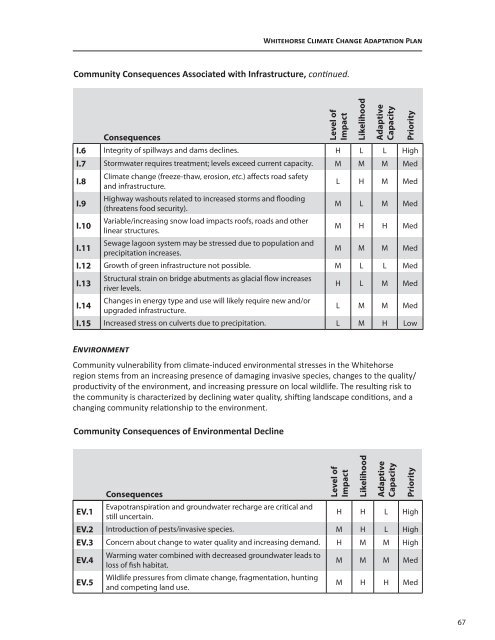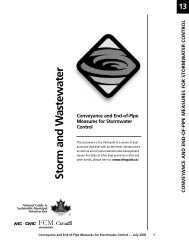Whitehorse Climate Change Adaptation Plan - Yukon College
Whitehorse Climate Change Adaptation Plan - Yukon College
Whitehorse Climate Change Adaptation Plan - Yukon College
You also want an ePaper? Increase the reach of your titles
YUMPU automatically turns print PDFs into web optimized ePapers that Google loves.
Environment<br />
<strong>Whitehorse</strong> <strong>Climate</strong> <strong>Change</strong> <strong>Adaptation</strong> <strong>Plan</strong><br />
Community Consequences Associated with Infrastructure, continued.<br />
Community vulnerability from climate-induced environmental stresses in the <strong>Whitehorse</strong><br />
region stems from an increasing presence of damaging invasive species, changes to the quality/<br />
productivity of the environment, and increasing pressure on local wildlife. The resulting risk to<br />
the community is characterized by declining water quality, shifting landscape conditions, and a<br />
changing community relationship to the environment.<br />
Community Consequences of Environmental Decline<br />
Impact<br />
Likelihood<br />
Adaptive<br />
Capacity<br />
of Level<br />
I.6<br />
Consequences<br />
Integrity of spillways and dams declines. H L L High<br />
I.7 Stormwater requires treatment; levels exceed current capacity. M M M Med<br />
I.8<br />
<strong>Climate</strong> change (freeze-thaw, erosion, etc.) affects road safety<br />
and infrastructure.<br />
L H M Med<br />
I.9<br />
Highway washouts related to increased storms and flooding<br />
(threatens food security).<br />
M L M Med<br />
I.10<br />
Variable/increasing snow load impacts roofs, roads and other<br />
linear structures.<br />
M H H Med<br />
I.11<br />
Sewage lagoon system may be stressed due to population and<br />
precipitation increases.<br />
M M M Med<br />
I.12 Growth of green infrastructure not possible. M L L Med<br />
I.13<br />
Structural strain on bridge abutments as glacial flow increases<br />
river levels.<br />
H L M Med<br />
I.14<br />
<strong>Change</strong>s in energy type and use will likely require new and/or<br />
upgraded infrastructure.<br />
L M M Med<br />
I.15 Increased stress on culverts due to precipitation. L M H Low<br />
Impact<br />
Likelihood<br />
Adaptive<br />
Capacity<br />
of Level<br />
EV.1<br />
Consequences<br />
Evapotranspiration and groundwater recharge are critical and<br />
still uncertain.<br />
H H L High<br />
EV.2 Introduction of pests/invasive species. M H L High<br />
EV.3 Concern about change to water quality and increasing demand. H M M High<br />
EV.4<br />
Warming water combined with decreased groundwater leads to<br />
loss of fish habitat.<br />
M M M Med<br />
EV.5<br />
Wildlife pressures from climate change, fragmentation, hunting<br />
and competing land use.<br />
M H H Med<br />
Priority<br />
Priority<br />
67

















